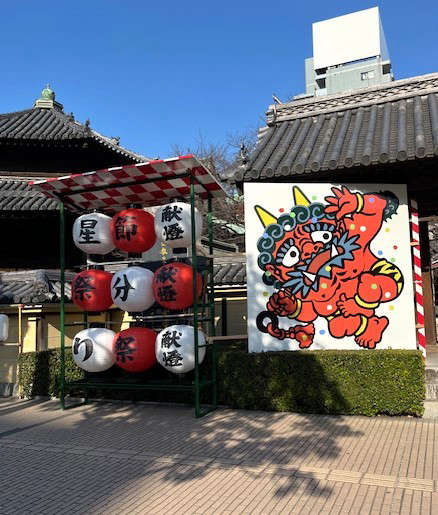
Setsubun is a religious holiday in Japan, but not a national holiday, so it is treated mostly like any other regular day.
The term “setsubun” generally means “seasonal division” and it occurs one day before the start of spring each year according to the Japanese lunar calendar. This year it occurs on Feb. 2, but it can also occur on Feb. 2, Feb. 3 or Feb. 4, depending upon the lunar calendar.
The main objective of setsubun is to chase away any evil spirits, devils, or demons that may be lurking or skulking around from the cold winter months, signaling the start of the spring season.
Centuries ago, people would cast out the evil spirits by burning dried fish heads which was believed (at the time) to be very unpleasant to the evil spirits — the demons found the strong smoky smell to be annoying, causing them to flee the premises. No doubt, the family members likely found the odor and murky, smelly air to be equally unpleasant, but it was a necessary effort to rid the house of any unwanted demons. Also, some regions of Japan used drums to drive away the evil spirits.
Called hiiragi iwashi, a ritual still done in some parts of the Kansai region of Japan, sardine heads are placed on holly branches, then these are attached to the front door. Again, it is believed that the demons have an aversion to the sardine heads that give off a pungent odor, and the spiky leaves of the holly branches are too prickly for the devils, so they avoid the home.
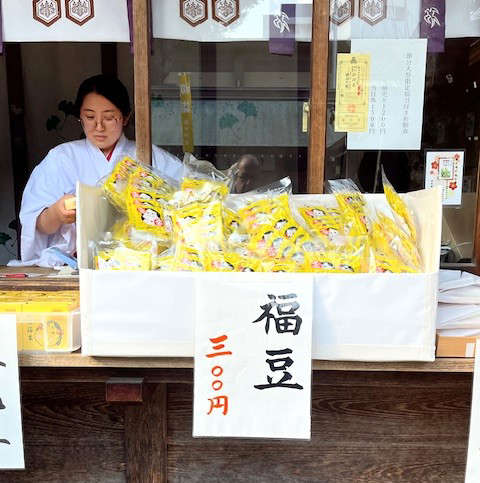
Today, most people partake in a setsubun ritual called “mamemaki” which means “bean scattering.” This ritual is especially enjoyed by children because it gives them an opportunity to be very messy by throwing beans around the house.
Often times, Japanese fathers will put on a devil’s mask and come to the door and pretend to try and break into the house and the kids grab handfuls of beans to cast at him to drive “the devil” out. There is no real illusion that it isn’t “papa” who is donning the devil’s mask for the older children (the younger ones may really believe it is a devil), but it is a tradition that has endured for generations.
As the children throw the roasted soybeans (“fukumame”) around the house and out the door, they shout “Oni wa soto! Fuku wa uchi! (“Devil be gone! Fortune come in!”). After the ritual, those who participated are supposed to pick up the number of beans to eat that corresponds to their ages. A friend once told me that her kids loved doing it so much that she would find the roasted beans months after the initial celebration, wedged in sofa cushions, under furniture, etc.
Many temples and shrines around Japan will host Setsubun celebrations with special events and activities. Often times, larger, more well-known temples will have celebrities, either from television or films, sumo wrestlers, or kabuki actors come to throw lucky beans to the crowds for good luck. It is considered quite auspicious to catch a packet of beans thrown by someone at a shrine or temple.
In the 90s, I remember Cyndi Lauper coming to Japan to participate in a Setsubun festival at Senso-ji Temple in Asakusa.
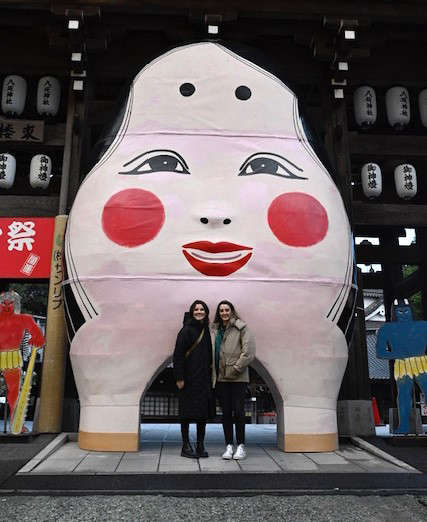
Well before the actual holiday, temples and shrines prepare for the throngs of people who will come to participate. The entrances to the temple or shrine grounds are decorated with huge, good fortune masks (photo) called “otafuku.” These are always depicted as cheerful, smiling Japanese females who bring good fortune and happiness to any man she marries.
Some shrines and temples also have a large depiction of a devil displayed.
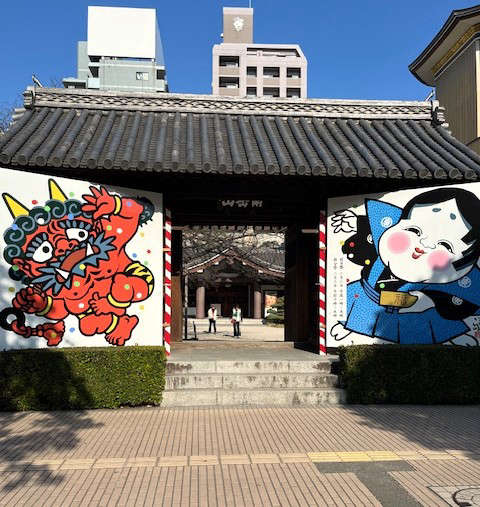
The reason the “otafuku” is used during setsubun stems back to a legend that involved a traditional Kyogen comedic play performance. In the comedy, the Otafuku’s sweetness was able to persuade an “oni” (devil) to change his evil ways. This persuasive act established the smiling woman as a symbol of good fortune, and she is often placed or depicted alongside the devil at temples and shrines (photo).
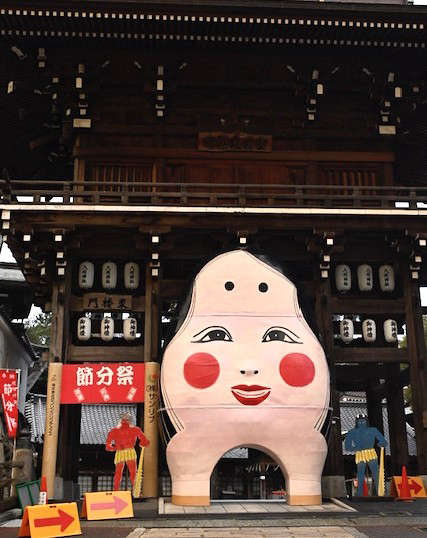
My prefecture, Fukuoka, boasts the largest Otafuku mask in Japan, and it is placed so attendees have to enter the temple grounds through the mask’s mouth. This is located at Kushida Shrine, and well before the actual holiday, preparations are made, and beans are sold to attendees. Beans purchased at a shrine or temple are considered to be especially lucky, so people try to pick these up when visiting the temple or shrine to improve their odds of having a luckier or more auspicious year (photo).
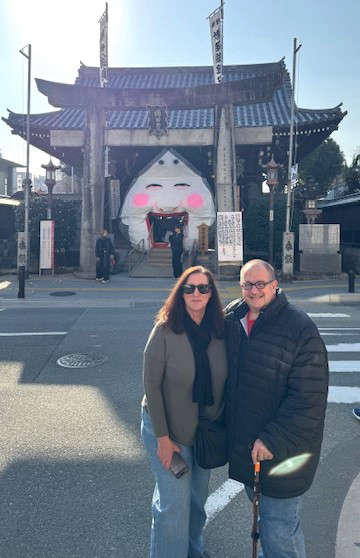
Samantha and Todd Leonard visit the Kushida Shrine.
Another ritual that is done for Setsubun by some families is eating “eho-maki” sushi (lucky direction sushi roll). The idea is to eat the extra-long sushi roll in its entirety silently while making a wish, all the while facing that year’s lucky direction, which is decided by the Chinese zodiac. This year’s lucky direction for Feb. 2, 2025, is west-southwest.
The setsubun festival is fun for children, and many families make an effort to celebrate the holiday for the sake of the children in the family. Drive out any demons and only usher in good fortune for 2025!


 800 East impacted by road project next week
800 East impacted by road project next week
 State Road 9 to close south of Shelbyville for structure replacement
State Road 9 to close south of Shelbyville for structure replacement
 Shelby County Special Olympics teams excel at Petrie Memorial Tournament
Shelby County Special Olympics teams excel at Petrie Memorial Tournament
 Ramp closures, traffic shift planned on I-70 in Hancock County
Ramp closures, traffic shift planned on I-70 in Hancock County
 Hendricks Green, Loper White win boys’ elementary basketball championships
Hendricks Green, Loper White win boys’ elementary basketball championships
 National Weather Service to issue a test tornado warning alert on Tuesday
National Weather Service to issue a test tornado warning alert on Tuesday
 Name of I-74 crash fatality released
Name of I-74 crash fatality released
 Triton Central's defense stifles Scecina to capture third sectional title in five years
Triton Central's defense stifles Scecina to capture third sectional title in five years




